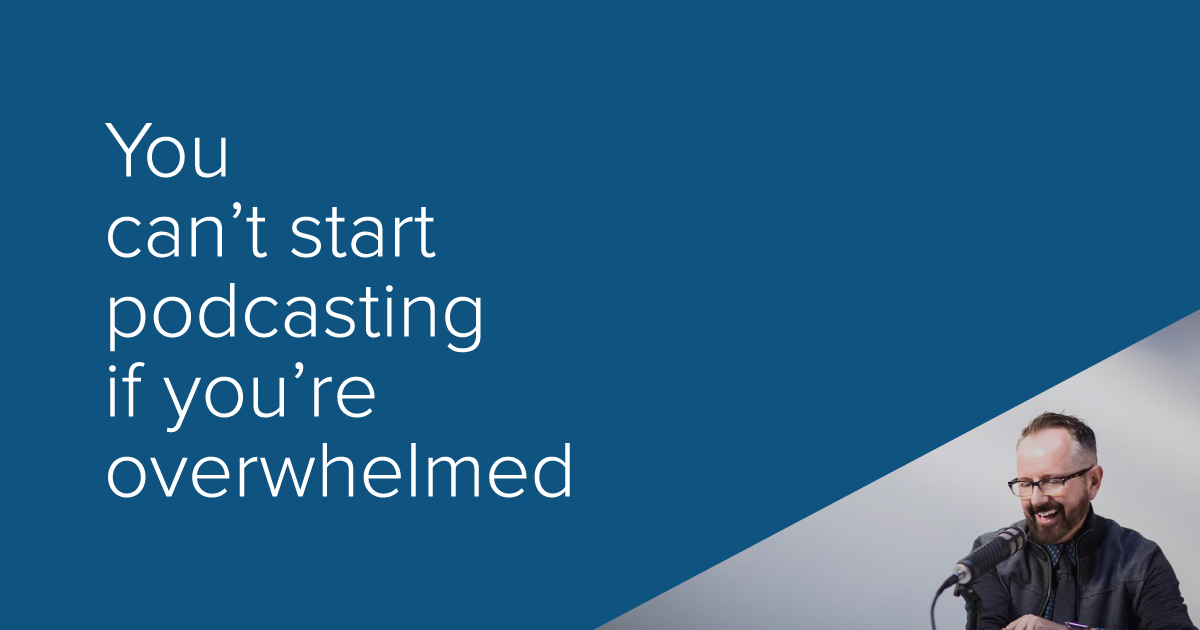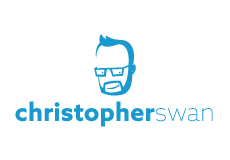
05 Mar Get Started Podcasting: Equipment, Tools and Advice
You’re thinking about podcasting. Or, you want up your show game. But you’re not sure what equipment to use, how to get started, and what to focus on to make your show something special. I was once there too.
I’ve been podcasting for two years, started as a newbie, knowing nothing, and I’ve evolved my show to become something that’s admired and deeply resonates with my audience. I also understand the desire to create something special, that rises above the thousands of mediocre shows.
These are my recommendation for equipment and tools—the equipment and tools I use, why I use them, and related advice I’ve learned along my podcasting adventure.
This post cuts through the endless list of equipment and tool options, to help you start podcasting quicker. It’s especially helpful if you want to host an interview-based show.
The Quick List: My Podcast Equipment & Tools
Equipment
Mics: Rode Procaster, Audio-Technica AT899 Condenser Lavalier, Zoom H6 Mic Attachments
Mic Stands: Rode Boom Arm PSA1 with Shockmount PSM1, Ultimate Support JSDMS50, LyxPro DKS-1
Audio Recorder: Zoom H6
Headphones: Sony MDR7506, Audio-Technica ATH-M50x
Accessories: Pop Shields (Auphonix 6-Inch), Cables (Planet Waves Custom Series XLR, 10ft, 25 ft), Headphone Splitter (Belkin Rockstar 5-Jack Multi Headphone Audio Splitter), Memory Cards (ScanDisk Ultra microSDXC 128GB & 64GB), Windscreens (Movo WS-G9 Furry Outdoor Microphone Windscreen Muff), Zoom H6 Power (Mediabridge USB 2.0, Zoom AD-17 Replacement AC Adapter), Twist Ties (Nite Ize GTBA-A2-R8 Original Gear Tie)
Full disclosure: The links above are affiliate links. That means, if you purchase products via one of these links, I earn a little money. There’s literally no price difference for you. It’s just an awesome way to say thanks to me.
Core Tools
Hosting: Libsyn
Guest Research and Tracking: Google Sheets
Interview Scheduling: Acuity Scheduling
Release Form Signature: Adobe Sign
Remote Interviews: Skype
Why I use this equipment – details and advice
MICS
The Rode Procaster is my standard mic for interviews with rich, clean sound. It’s ideal for quiet spaces. It minimizes sounds from the sides and front of the mic, and is a good choice for a one person per mic set up. These are not travel mics and the weight can add up quickly. But for me, it’s worth the travel gripes to have studio quality sound in a guest’s house or office.
Audio-Technica AT899 Condenser Lavaliers are traditionally used for TV and stage. I use them when a small footprint is needed due to size or configuration of interview space (e.g., in a car). Since they clip on easily, the mics practically disappear.
The mic attachments that come standard with the Zoom H6 capture just enough environmental/on the street sounds, and the quality work well. I do use a furry wind protector when outdoor scenes, or you’ll only hear wind.
The most important tip about mics, make sure they sound great. Listeners hate poor audio and they’ll be more willing to stop listening.
MIC STANDS
I used two different stands, one for my home office/studio, and the other when I’m traveling.
I want easy access to my mic in my home office to record on the fly, as I often need to make a new intro, create a new insert, etc. Here’s a simple rule to live by when it comes to any equipment and creativity: The less you need to set up, the more you’ll make the recordings happen. I made a semi-permanent setup with the Rode Boom Arm (and shockmount) attached to my desk to achieve this option.
The small desk stands (I have two very similar varieties) are my go to when traveling. These break down easily, even if they can be a bit heavy. Most importantly, they are sturdy enough to support the Procaster.
Comfort and usefulness: There are various versions of stands and I’ve tried a handful of them, including floor stands), and even swamped some out. Chose sizes based on your typical setup/needs, and make sure the overall setup feels comfortable for you (and your guests).
AUDIO RECORDER
I record all of my audio through the Zoom H6. This provides great options for audio in studio, traveling, on the street, etc. It also has a ton of features that have come in handy. For example, if you’re using their mic attachment and I have the gain up to high, the H6 automatically creates a back up in a lower gain. This has literally saved one of my interviews.
Many beginners start off recording through their computer. That’ll definitely save you money. But computers have issues (eg., freezing, slowing down, crashes, software issues). When that happens, you can end up with corrupted audio files. Imagine losing that interview you just completed. Now imagine explaining that to your guest?! But, a computer is an okay place to start if you’re gauging your interest in podcasting still. This will save you money if it’s a short-lived hobby.
A portable recorder allows you to record where you want, record multiple people in-person, and it’s a superior tool for people serious about creating a respected show. When I’m on the road this is a must-have to capture what I need. With the included mic attachments, I’m literally walking and recording through airports, farms, car trips, elevators, city streets, etc.
The Zoom is available in different models. I went with the H6 to make sure I could easily expand the number of mics that can be attached, equaling how many guests I could include in the episode. Hint: (that’s what the 6 stands for, 6 mics). If you’ll only ever have one guest, or just yourself, aim for a lower priced model and you’ll still have great options.
HEADPHONES
I generally use the same headphones as my guest. This makes sure the sound I’m hearing is measured by the same standard as my guests. Then I can adjust inputs/gains with confidence.
But first start with comfort as you choose headphones. As you’ll have them on for an extended period of time, you want to make sure they are not too tight. This will bother you more than you realize after an hour of tight headphones.
I chose headphones that were mid-range in price. I wanted them to provide a comfortable experience with clear sound.
If you’re editing your own show, headphones are even more important. Don’t skimp here. You need to hear the audio well, and the headphones need to be super comfy.
ACCESSORIES
Some accessories are must-haves while others are nice-to-haves. Also, the specifics (like length of cable, etc.) will depend on your set up.
Pop shields are a must in my book. The Procaster mics have built in shields. But I like the extra protection. Also, don’t speak so close to the mic to reduce the pops.
Cables are necessary to connect everything. Go for trusted quality and having extra sizes is always handy. Nothing fancy is necessary.
Have multiple guests on your shows? They all need headphones. Get a splitter that can plug into the audio recorder output port. These are cheap and no frills.
You need memory cards to store the audio. Cards get damaged. Always carry a back up. Always!
If you’re capturing audio outside, cover the mic with a windscreen. This reduces wind noise, something no listener wants to hear.
The Zoom H6 runs on batteries. This is great for portability. But, save yourself some money (and the environment) and purchase the power AC option if you’ll be near power outlets.
Now about the tools, and why they matter
First thing we should clear up—the necessary (or required) tools will vary depending on your needs. The key is to use tools that streamline your processes, keeps you organized, and makes for a great experience (for you and your guests). You may also find that your need for some tools change as time goes on. This has happened for me as my show evolved.
We all need hosting. Podcast files are hosted in one place (a server) and sent to places like iTunes and Stitcher to be distributed to your listeners. I went with Libsyn as they were an easy standard to start—not necessarily because they are the best. They are a solid choice. There are also a lot of options out there. If you want a different option, look for dependable and read the fine print (AKA, see what the hosting company can/ cannot do with your show).
Will you have guests on your show? These options are for you.
Guest Scheduling. When I started, I hosted a weekly ongoing show, and I interviewed a lot of guests. Researching and scheduling became a job. Instead, let guests schedule themselves on your online scheduling system. Acuity Scheduling is easy to use, priced well, it’s customizable, and can be added to your website. It also has customizable follow up emails. This has been a solid tool for me. I do not use it for scheduling now as my needs changed. But I keep it for other uses.
Guest Research and Tracking. Google Sheets became my go to tool. I created a worksheet to track my guest research, communications, requests for assets, and episode status. Staying organized is key here. This allowed me to plan my next guests, track who replies, what they said, no replies, when I received the signed release form and pictures, and when the interview is completed. All of this information was super valuable for me to plan and track my episodes.
For some of you, this may be too much. If it is, find/create a system that works for you. The better the process, the better your productivity and your pre-interview guest experience. Why not try out mine. Or grab it and modify a copy to meet your needs.
Guest Release Form. Not everyone asks guests to sign releases. I’m a believer in protecting myself. This release form allows you to use the recording for your purposes and it reduces the risk of liability. It may seem formal and uncomfortable to request this from your guest, especially if they push back. After 70+ interviews I’ve only had one person that refused to sign it, and two requests for special edits.
Not sure where to start? Take a look at mine as a starting spot. Copy it and make it work for you. Whatever you end up using, it would be advisable to have a lawyer review it. Even if you don’t, it’s still better to have one in place than not.
Remote Interviews. I have used Skype with mostly acceptable quality. This is when I use my computer for Skype, and connect my computer to my Zoom H6. The truth with remote interviews, the sound quality will never be perfect unless you’re in remote radio stations. There are a few tools in the market you can try, like Zencastr, Cast, and Ringr). I’ve used a few of them and they all have problems-typically due to the bandwidth of the guest. Skype is fairly easy to use and most people will use it when you make it easy for them. That was my guiding rule for a remote tool—it has to be easy for the guest. So whatever remote tool you use, make it frictionless for them.
Editing: I do not personally edit my show. With that said, I do not have a specific tool recommendation. If you’re debating about outsourcing your editing, I recommend it. Your time savings than can be applied to finding guests, improving your show, marketing, etc. Do what you’re great at and outsource what you’re not (and can get out the door). If you go this route, use a vendor that will work with your style and vision. If they don’t get it, don’t use them, no matter how cheap their prices.
Here’s the thing:
There are tons of equipment and tool options—and many of them will work. But it’s also overwhelming to research them all. I know, I did it. Start with a few, and test new ones as you go. The point here, just start. Don’t get stuck in the research zone.
Now that you have a list of equipment and tools, you need to put it all into action. So…
Do you need help starting? How can I help you launch your show?





Sorry, the comment form is closed at this time.